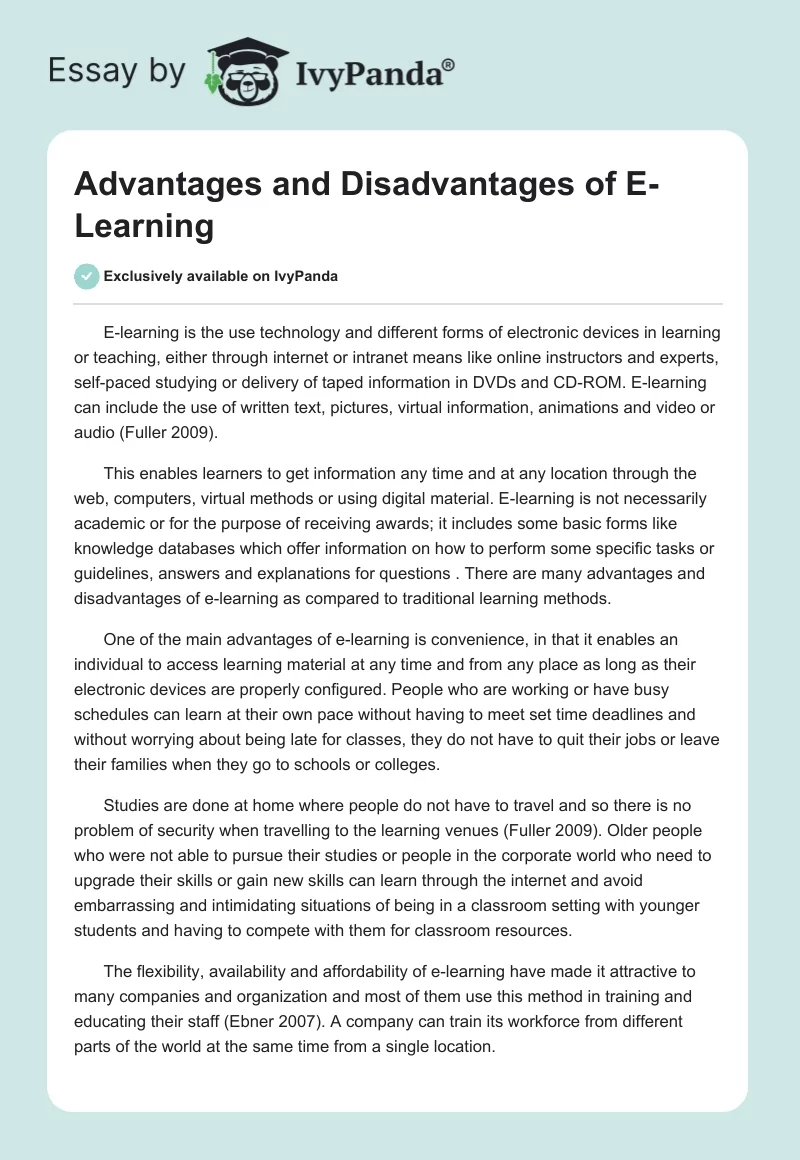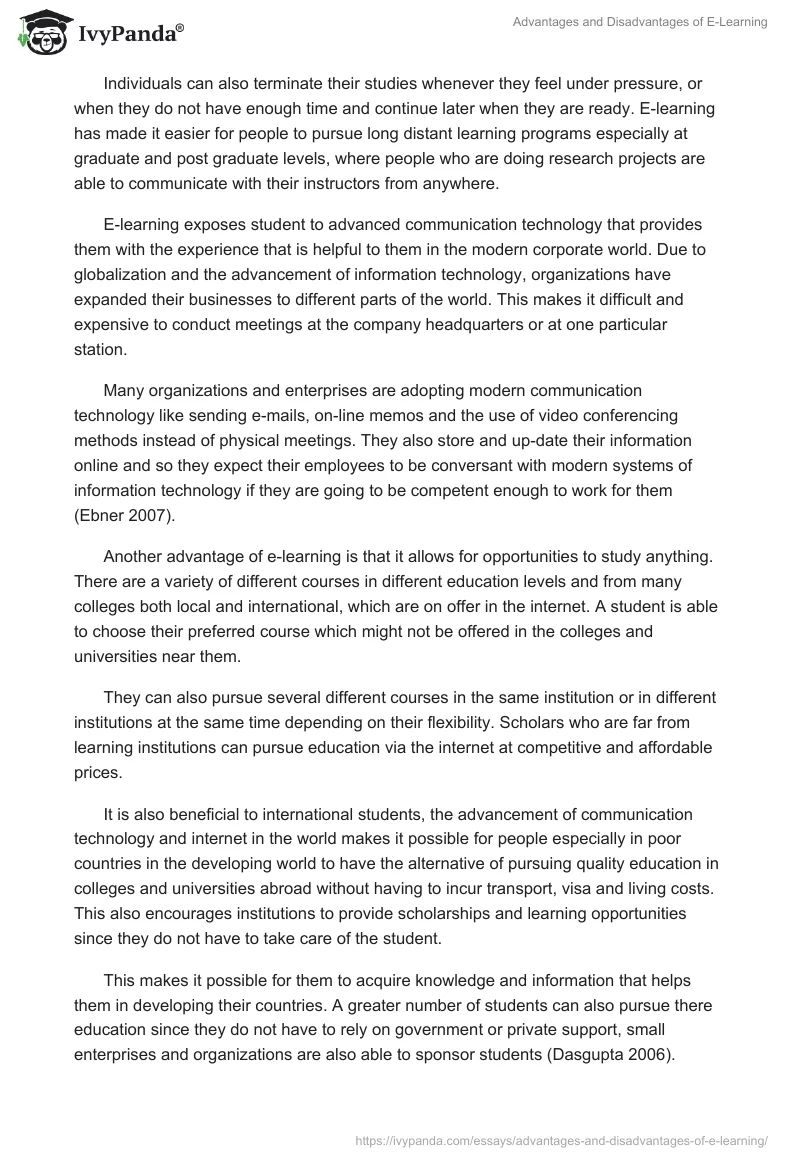E-learning is the use technology and different forms of electronic devices in learning or teaching, either through internet or intranet means like online instructors and experts, self-paced studying or delivery of taped information in DVDs and CD-ROM. E-learning can include the use of written text, pictures, virtual information, animations and video or audio (Fuller 2009).
This enables learners to get information any time and at any location through the web, computers, virtual methods or using digital material. E-learning is not necessarily academic or for the purpose of receiving awards; it includes some basic forms like knowledge databases which offer information on how to perform some specific tasks or guidelines, answers and explanations for questions . There are many advantages and disadvantages of e-learning as compared to traditional learning methods.
One of the main advantages of e-learning is convenience, in that it enables an individual to access learning material at any time and from any place as long as their electronic devices are properly configured. People who are working or have busy schedules can learn at their own pace without having to meet set time deadlines and without worrying about being late for classes, they do not have to quit their jobs or leave their families when they go to schools or colleges.
Studies are done at home where people do not have to travel and so there is no problem of security when travelling to the learning venues (Fuller 2009). Older people who were not able to pursue their studies or people in the corporate world who need to upgrade their skills or gain new skills can learn through the internet and avoid embarrassing and intimidating situations of being in a classroom setting with younger students and having to compete with them for classroom resources.
The flexibility, availability and affordability of e-learning have made it attractive to many companies and organization and most of them use this method in training and educating their staff (Ebner 2007). A company can train its workforce from different parts of the world at the same time from a single location.
Individuals can also terminate their studies whenever they feel under pressure, or when they do not have enough time and continue later when they are ready. E-learning has made it easier for people to pursue long distant learning programs especially at graduate and post graduate levels, where people who are doing research projects are able to communicate with their instructors from anywhere.
E-learning exposes student to advanced communication technology that provides them with the experience that is helpful to them in the modern corporate world. Due to globalization and the advancement of information technology, organizations have expanded their businesses to different parts of the world. This makes it difficult and expensive to conduct meetings at the company headquarters or at one particular station.
Many organizations and enterprises are adopting modern communication technology like sending e-mails, on-line memos and the use of video conferencing methods instead of physical meetings. They also store and up-date their information online and so they expect their employees to be conversant with modern systems of information technology if they are going to be competent enough to work for them (Ebner 2007).
Another advantage of e-learning is that it allows for opportunities to study anything. There are a variety of different courses in different education levels and from many colleges both local and international, which are on offer in the internet. A student is able to choose their preferred course which might not be offered in the colleges and universities near them.
They can also pursue several different courses in the same institution or in different institutions at the same time depending on their flexibility. Scholars who are far from learning institutions can pursue education via the internet at competitive and affordable prices.
It is also beneficial to international students, the advancement of communication technology and internet in the world makes it possible for people especially in poor countries in the developing world to have the alternative of pursuing quality education in colleges and universities abroad without having to incur transport, visa and living costs. This also encourages institutions to provide scholarships and learning opportunities since they do not have to take care of the student.
This makes it possible for them to acquire knowledge and information that helps them in developing their countries. A greater number of students can also pursue there education since they do not have to rely on government or private support, small enterprises and organizations are also able to sponsor students (Dasgupta 2006). Research information can be retrieved from the internet with the availability of online journals, books, web articles, and magazines, et cetera.
E-learning is also cheap as compared to classroom learning with the reduction of print material, furniture and teachers salaries, one reading session can hold a bigger number of student who cannot be contained in a single classroom or lecture theatre (Fuller,2009 ).
The created material can be accessed in the internet and it can be easily stored or transferred sometimes with the payment of a small fee, this reduces the necessity of having to go to a library or buying whole books and journals when one is interested in a particular topic or article. This material remains in the internet and it is not easily tampered and so its quality and reliability is guaranteed (Ebner 2007).
Another advantage of e-learning is interacting and socializing with other student who come from different areas, in more advanced situations the use of on-line discussions groups, e-mails and video conferencing enables student to exchange information and reading materials.
They can also assist each other with problems in their studies without having to meet through collaborative learning (Ebner 2007). Students can meet other people with similar learning styles who are from different cultures and backgrounds. The interaction and integration of students from different cultures diversifies their learning especially on social and other non-scientific subjects. There are healthier and interesting discussions and debates. Students are able to look at their learning from different perspectives.
A disadvantage of e- learning is that it requires computer and internet knowledge and skills and most people might not have them, it is highly sophisticated and that makes it expensive (Ebner 2007).
It also requires one to have uninterrupted and easy internet and computer access, one must be computer savvy to be able to obtain full advantage of this method of learning and also keep on updating themselves on new technological innovations and developments. People have to keep updating themselves with new material from time to time or else they are left behind in their studies (Fuller 2009).
E-learning lacks physical interaction between students and their teachers and among students themselves as compared to a classroom setting. It mainly depends on student initiative and the students are responsible for their learning.
This can be a disadvantage to those students who learn at slow pace and need assistance or to ask questions because they might be left behind or miss important points (Dasgupta 2006). It is difficult to teach subjects that require discussions and debates because even when there is opportunity for interaction, the time is limited and very few people can participate.
E-learning can also be boring and tiring when an individual has to sit in front of a computer or listen to an educational tape or video for many hours alone without any other form of interaction which they can also take part, they can doze off.
There have been arguments about health problems and issues that are related with spending huge amount of times on computers, some people argue that this has a bad impact on socialization, there are also problems associated with lack of exercise due to long sitting hours like obesity and also eyesight complications (Dasgupta 2006).
Another problem of e-learning is that people who have a short concentration span might not be able to concentrate when they are studying, either because of the environments in which they are studying or because they get easily distracted, for example in the case of nursing mothers and housewives.
A classroom setting ensures that people have close and one on one contact with their trainers and this can increase their concentration, there are opportunities for teamwork and group work in classes and students can ask questions or discuss.
There is also no follow up on students who drop out of e-learning either because they loose interest or because they lack the time to continue studying or they do not have the competence in using information technology. It is easier for students to copy and cheat in assignments especially when there are no sit-in exams. Students can pay other people to do their assignments for them or submit copied work without being noticed by their supervisors.
Another problem is assessing the standard, quality and effectiveness of e-learning based courses. Due to the large number and wide variety of courses offered in e-learning, it is difficult to ascertain the impact and quality of knowledge that many e-learning students acquire and whether they are able to keep and apply the acquired knowledge in their different fields and professions when they get through with their studies (Dasgupta 2006 ).
E-learning is also not effective when learning sciences or performing scientific experiments. Although there might be well outlined and elaborated guidelines, there is still need for physical supervision to make sure that students clearly understand and follow the instructions and to also make sure that the results are correct and consistent.
This cannot be done through e-learning because the instructor needs to teach and observe every student individually. Most applied sciences which involve practical experiments can only be taught effectively in a classroom or laboratory setting. E-learning can also be challenging when learning languages with parts and sounds that require listening and practicing. Many people learn foreign languages in colleges and e-learning might not effectively deliver this knowledge.
E-learning has its many advantages and disadvantages. It is important to note that with the rapid spread and advancement of information technology, it is the best way of acquiring education. It is also preferred when there is time constraint and its costs are much less than those of other traditional forms of teaching (Fuller 2009). Blending of e-learning and other traditional classroom and visual methods ensures that students are able to receive better and quality education.
Reference List
Ebner, K., 2007, The Impact of Introducing E-learning Courses. Norderstedt: GRIN.
Fuller, C., 2009. Advantages and Disadvantages to eLearning. Web.
Dasgupta, S., 2006, Encyclopedia of virtual communities and technologies. London: Idea Group Ltd.


